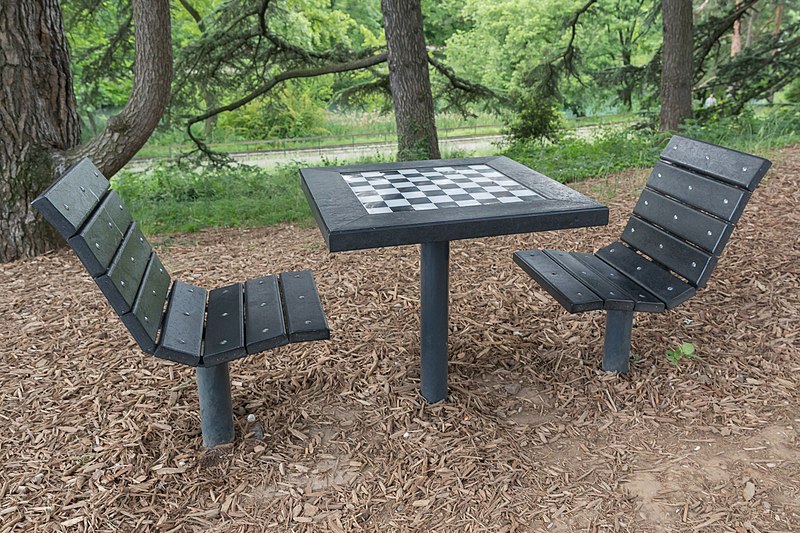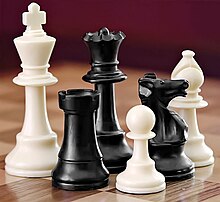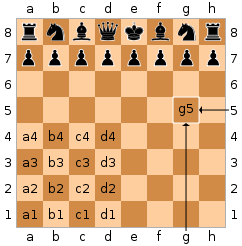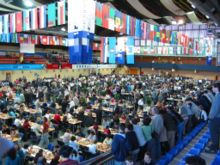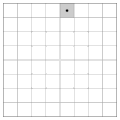Our website is made possible by displaying online advertisements to our visitors.
Please consider supporting us by disabling your ad blocker.
Portal:Chess
Introduction
Chess is a board game for two players. It is sometimes called international chess or Western chess to distinguish it from related games such as xiangqi (Chinese chess) and shogi (Japanese chess).
Chess is an abstract strategy game that involves no hidden information and no elements of chance. It is played on a chessboard with 64 squares arranged in an 8×8 grid. The players, referred to as "White" and "Black", each control sixteen pieces: one king, one queen, two rooks, two bishops, two knights, and eight pawns. White moves first, followed by Black. The game is typically won by checkmating the opponent's king, i.e. threatening it with inescapable capture. There are several ways a game can end in a draw.
The recorded history of chess goes back at least to the emergence of a similar game, chaturanga, in seventh-century India. After its introduction in Persia, it spread to the Arab world and then to Europe. The rules of chess as they are known today emerged in Europe at the end of the 15th century, with standardization and universal acceptance by the end of the 19th century. Today, chess is one of the world's most popular games and is played by millions of people worldwide. (Full article...)
Selected article -
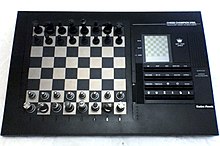
Computer chess includes both hardware (dedicated computers) and software capable of playing chess. Computer chess provides opportunities for players to practice even in the absence of human opponents, and also provides opportunities for analysis, entertainment and training. Computer chess applications that play at the level of a chess grandmaster or higher are available on hardware from supercomputers to smart phones. Standalone chess-playing machines are also available. Stockfish, Leela Chess Zero, GNU Chess, Fruit, and other free open source applications are available for various platforms.
Computer chess applications, whether implemented in hardware or software, utilize different strategies than humans to choose their moves: they use heuristic methods to build, search and evaluate trees representing sequences of moves from the current position and attempt to execute the best such sequence during play. Such trees are typically quite large, thousands to millions of nodes. The computational speed of modern computers, capable of processing tens of thousands to hundreds of thousands of nodes or more per second, along with extension and reduction heuristics that narrow the tree to mostly relevant nodes, make such an approach effective. (Full article...)
General images
Selected image
FIDE world ranking
| Rank | Player | Rating |
|---|---|---|
| 1 | 2831 | |
| 2 | 2802 | |
| 3 | 2797 | |
| 4 | 2796 | |
| 5 | 2794 | |
| 6 | 2783 | |
| 7 | 2767 | |
| 8 | 2763 | |
| 9 | 2755 | |
| 10 | 2751 | |
| 11 | 2751 | |
| 12 | 2746 | |
| 13 | 2741 | |
| 14 | 2740 | |
| 15 | 2739 | |
| 16 | 2738 | |
| 17 | 2735 | |
| 18 | 2733 | |
| 19 | 2733 | |
| 20 | 2728 |
Top 10 WikiProject Chess Popular articles of the month
Did you know...
- ... that Magnus Carlsen, the current World Chess Champion, resigned a recent tournament game after only one move?
Reviewed articles
Chess from A to Z
| Index: | A B C D E F G H I J K L M N O P Q R S T U V W X Y Z (0–9) |
| Glossary: | A B C D E F G H I J K L M N O P Q R S T U V W X Y Z |
Topics
Subcategories
Related portals
Related WikiProjects
Associated Wikimedia
The following Wikimedia Foundation sister projects provide more on this subject:
-
Commons
Free media repository -
Wikibooks
Free textbooks and manuals -
Wikidata
Free knowledge base -
Wikinews
Free-content news -
Wikiquote
Collection of quotations -
Wikisource
Free-content library -
Wikiversity
Free learning tools -
Wiktionary
Dictionary and thesaurus
Sources
Previous Page Next Page

